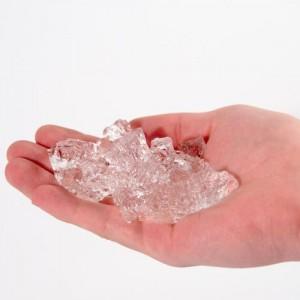Remember when Jell-o® advertised its product as the food that’s “fun to eat”? Jell-o® or, more generically, gelatin, is taking a serious role in the field of medical diagnostics — in 3D printed form. 3D printed electronic gelatin may eventually be used to get inside of a patient’s body and detect biochemical imbalances. Not unlike diagnostic tests that require patients to drink small amounts of dye or swallow capsules that aid in visualizing problems inside of the body when x-rays and other scans are performed, this 3D printed gelatin is edible. Instead of more invasive methods for introducing a visualizing agent, it can simply be consumed.
3D printed electronic gelatin is the brainchild of Australian chemist and Associate Professor of Chemistry at the University of Wollongong, Dr. Marc in het Panhuis. In het Panhuis and his team of researchers are working to develop edible hydrogels (a hydrogel is a colloidal gel in which water is the continuous phase). Anticipating the ever-expanding capacity of 3D printers to work with all kinds of materials, in het Panhuis’ team is trying to figure out how to make a hydrogel that is less fragile than the ones that are commonly used in the medical arena.
The researchers discovered that when they combined two different polymers, a much sturdier cross-linked molecular chain was formed. For example, they mixed genipin (“an anti-inflammatory agent derived from the fruit of the gardenia plant”) with gelatin. Additionally, they experimented with gellan gum, which is the thickener commonly found in puddings, sauces, jellies, and other, well, wiggly foods. To create the cross-linking, the team used common salt; by soaking gellum gum in table salt for a week, they produced a gel that was tougher and more stable.
Since hydrogels are made up primarily of water — as much as 97.5% — they are excellent conductors, particularly with the addition of sodium ions. In het Panhuis explained that when these conductive hydrogels are 3D printed, they will be heated and converted to a liquid state. As they cool over the course of a couple of hours, they set, much like the Jell-o® you and your mom used to make. The goal of in het Panhuis’ team is to produce a hydrogel that will be an edible biomedical sensor. The hydrogel would be “tunable.” That is, its electronic properties could be adjusted.
That’s the easy part, relatively speaking. More challenging, explained in het Panhuis, is to devise a way to read the information the edible sensors collect. One requirement would, of course, be that the edible sensors must be bite-size. The University of Wollongong team has funding for seven years, so in het Panhuis is confident they can develop this material so it can serve as an efficient diagnostic tool and discover other uses for it. In that regard, the chemist hopes to use 3D printed hydrogel or related materials for soft robotics.
One exciting potential application, clearly well down the road, is with 4D printing: 3D printed material that changes its shape or form. Let us know what you think of the potential for these exciting new biomedical applications over in the 3D Printed Hydrogel forum thread at 3DPB.com.
[Via: Discovery.com]Subscribe to Our Email Newsletter
Stay up-to-date on all the latest news from the 3D printing industry and receive information and offers from third party vendors.
You May Also Like
3D Printing Unpeeled: $5000 Cold Spray 3D Printer, Roland DGA & Living Materials
The AeroForge is a $5000 cold spray metal printer for copper made by a student team at Rice University. In a paper for ACS Central Science a team from Nanjing...
3D Printing Webinar and Event Roundup: April 28, 2024
In this week’s 3D Printing Webinar and Event Roundup, the Ceramics Expo is taking place in Michigan, Stratasys continues its advanced training courses, and SPE is holding a Polymer Characterization...
Meltio Expands Global Reach with New Partnerships in the Americas and Europe
Spanish 3D printing manufacturer Meltio has expanded its sales network across the globe. With the addition of three new partners in the United States, Brazil, Argentina, and Italy, Meltio aims...
US Army Corps of Engineers Taps Lincoln Electric & Eaton for Largest 3D Printed US Civil Works Part
The Soo Locks sit on the US-Canadian border, enabling maritime travel between Lake Superior and Lake Huron, from which ships can reach the rest of the Great Lakes. Crafts carrying...

































